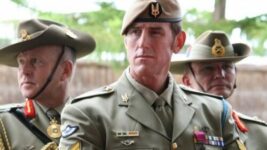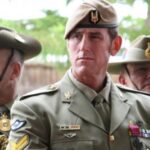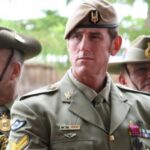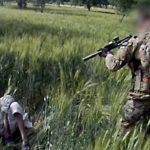SAS Soldier Allegedly Lies to Cover-Up for Ben Roberts-Smith

A former Australian Special Air Service (SAS) soldier who testified for Ben Roberts-Smith during his defamation case has been charged with obstructing, hindering, intimidating or resisting a Commonwealth official, as well as causing harm to a Commonwealth public official.
The story so far
Detectives attached to the Office of the Special Investigator arrested the former SAS soldier, who has been given the pseudonym ‘Person X’, just hours after he finished giving three days of evidence in defence of Ben Roberts-Smith.
Mr Roberts-Smith, who has been described as Australia’s most decorated soldier, is suing The Age, The Sydney Morning Herald and The Canberra Times for defamation. The newspapers are relying on a defence of truth.
The Brereton Report
The Brereton Report, led by NSW Supreme Court Justice Paul Brereton, was the result of four years of investigations and involved dozens of reports by Australian Defence Force personnel and thousands of pages of information.
The investigation uncovered at least 39 alleged murders of mainly civilians and unarmed captured Afghan troops, and the cruel, inhumane and degrading treatment of at least two more locals by specialist SAS Australian soldiers in Afghanistan.
It highlighted a range of serious issues within the culture of the ADF, finding that “the criminal behaviour of a few was commenced, committed, continued and concealed at the patrol commander level, that is, at corporal or sergeant level”.
Reports were received from Australian soldiers who could not bring themselves to support the “disregard for human life and dignity” shown by their rogue colleagues, nor the “culture of mateship and cover-ups” which enabled some soldiers to torture and kill with impunity.
The Office of the Special Investigator was charged specifically with addressing potential war crimes revealed in the report.
It has been working in cooperation with the Australian Federal Police.
Key witness
Person X accompanied Mr Roberts-Smith during a 2009 mission at a village compound designated Whiskey 108.
This is where the newspapers allege that two unarmed Afghan men were pulled from a tunnel and killed by SAS troops, which is against the rules of engagement of war, which prohibit the killing of unarmed prisoners.
Mr Roberts-Smith is alleged to have directed a junior soldier, Person 4, to execute one of the men, on the orders of Person X, and to have shot the other one himself.
One SAS soldier who testified on behalf of the newspapers, Person 14, told the court that the mission was over, he heard Person X saying, “I finally blooded the rookie”. This, as was uncovered in the Brereton investigations, meant a form of ‘initiation’ for new soldiers.
The court also heard from another witness, Person 24, that he saw Mr Roberts-Smith drop the other detainee to the ground and shoot him in the back, in what he interpreted as an “exhibition execution”.
Person X agreed under cross-examination that a total of five murder allegations had been made against the patrol he commanded with Roberts-Smith as 2IC (the second in command).
Mr Roberts Smith, who is one of Australia’s most decorated war veterans denies any wrongdoing and says that all of the killings were conducted within the laws of war.
The matter involving Person X will return to the Downing Centre Local Court on 21 June 2022.
In the meantime, he has been granted bail, including permission to fly overseas, but must return for the court hearing.
The offence of obstructing a Commonwealth Public Office
Obstructing a Commonwealth Public Official if an offence under section 149.1 of the Criminal Code Act 1995 which carries a maximum penalty of 2 years in prison.
The section states that a person is guilty of the offence if the prosecution proves that:
- The defendant obstructed, hindered, intimidated or resisted an official in the performance of the official’s functions,
- The official was a Commonwealth public official,
- The functions were those of a Commonwealth public official, and
- The defendant knew the official was a Commonwealth public official.
Despite the above, the section proceeds to state that it is not essential for the prosecution to prove that the defendant knew:
- That the official was a Commonwealth public official, or
- That the functions were functions as a Commonwealth public official.
The section defines ‘function’ as:
- In the event it relates to a person who is a public official: any authority, duty, function or power that is conferred on the person as a public official, or
- In the event it relates to a person who is a Commonwealth public official: any authority, duty, function or power that is conferred on the person as a Commonwealth public official.
Self-defence, duress and necessity are defences to the charge.
What is a Commonwealth public official?
The definition of ‘Commonwealth public official’ encompasses a broad range of Commonwealth employees and officers, Members of Parliament, judges, police, contractors, military personnel and those employed by Commonwealth authorities.
The offence of causing harm to a Commonwealth Public Official
Causing Harm to Commonwealth Public Official an offence under section 147.1 of the Criminal Code Act which carries a maximum penalty of 13 years in prison if the official is a Commonwealth judicial officer or a Commonwealth law enforcement officer, or 10 years in any other case.
To establish the offence, the prosecution must prove beyond reasonable doubt that:
- The defendant engaged in conduct,
- The conduct caused harm to a public official,
- The defendant intended for his or her conduct to cause harm to the official,
- The harm was caused without the consent of the official, and
- The defendant engaged in his or her conduct because of:
(i) the official’s status as a public official, or
(ii) any conduct engaged in by the official in the official’s capacity as a public official.
Self-defence, duress and necessity are also defences to this charge.







